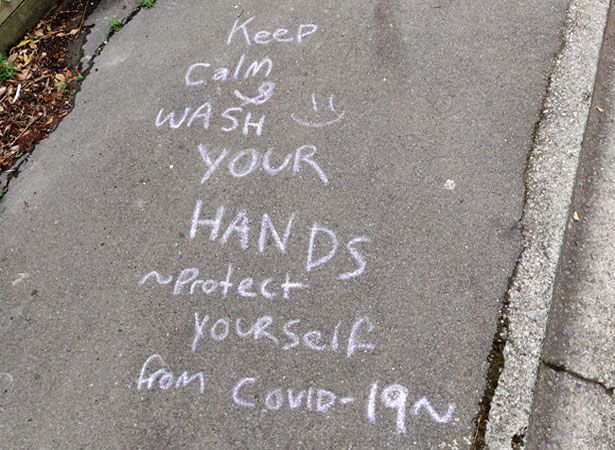
At 11.59 p.m. on Wednesday 25 March 2020, New Zealand entered a nationwide lockdown designed to prevent the spread of the deadly COVID-19 virus around the country.
COVID-19 (SARS-CoV-2), a new type of coronavirus affecting the respiratory system, had begun spreading around the world in January and February, quickly overwhelming health systems and causing widespread loss of life. As the global situation deteriorated, international travel became increasingly fraught. Entry into the country from overseas virus hotspots was restricted, while New Zealanders stranded overseas struggled to return home as flights were cancelled and airlines suspended services. On 19 March, for the first time in the country’s history, the government closed the borders to anyone who wasn’t a citizen, permanent resident, or their partner or child (who could enter New Zealand only if travelling with them). Those arriving were required to self-isolate for 14 days.
New Zealand had reported its first case of the virus on 28 February, 12 days before the World Health Organisation (WHO) declared a global pandemic. As the number of local coronavirus cases grew, the government introduced measures to control the spread of the virus. By Saturday 21 March, the total number of confirmed and probable cases had reached 88. On the same day, in a historic address to the nation, Prime Minister Jacinda Ardern introduced a new four-level alert system which restricted human contact, travel and business operations. The country immediately moved to Alert Level 2, which required New Zealanders to stay at home as much as possible, including by working from home and limiting non-essential travel.
Two days later, as total confirmed and probable cases doubled to 173, Ardern announced that the country would move immediately to Alert Level 3, to be followed two days later by a move to Alert Level 4, the highest level. Under level 4 restrictions, all New Zealanders were instructed to stay at home and to have physical contact only with those in their ‘bubble’. The decision came after public health officials were unable to trace the source of two cases of community transmission. At a press conference announcing the change, Ardern explained the reason for the looming lockdown:
[W]e now consider there is transmission within our communities. If community transmission takes off in New Zealand, the number of cases will double every five days. If that happens unchecked, our health system will be inundated, and tens of thousands of New Zealanders will die. … Right now we have a window of opportunity to break the chain of community transmission, to contain the virus, to stop it multiplying, and to protect New Zealanders from the worst. Our plan is simple. We can stop the spread by staying at home and reducing contact. Now is the time to act.
As New Zealanders prepared to enter a nationwide lockdown, many raced to get home from other regions before Alert Level 4 came into effect. Others, uncertain about how long the lockdown would last, began panic buying. Supermarket shelves were cleared of bread, flour and toilet paper, homeware stores of bread makers, cookware and other kitchen utensils, and hardware stores of home improvement materials. The government also declared a state of national emergency on 25 March. This would last for close to two months until it was lifted on 13 May 2020.
On the morning of 26 March, New Zealanders awoke to a strange new world of empty streets, parks, playgrounds and roads. Gatherings – including tangihanga, funerals and weddings – were prohibited and public venues shut, and travel outside local areas was restricted. All businesses, save for those deemed essential, closed, as did educational facilities. Such action was unprecedented in peacetime New Zealand. Activities such as exercising and going to the supermarket or to medical appointments were still permitted.
Over the next few weeks, the country adjusted to the new reality of life under lockdown. Parents and caregivers turned their homes into classrooms, while those able to work from home set up workstations at kitchen tables or wherever they could find a flat surface. With the support of police, various iwi established checkpoints on roads leading into their rohe to prevent those who didn’t live or work locally from entering. Many businesses struggled to stay viable, even with the aid of support schemes introduced by the government.
The level 4 lockdown lasted just over a month, ending with a shift to Alert Level 3 on 27 April. As the rate of infection stabilised, the country shifted further down alert levels. By the time New Zealand moved to Level 1 on 8 June, the total number of probable and confirmed cases had reached 1505, with 22 deaths. This was a stark contrast to the global situation, with 6,917,871 confirmed cases worldwide, and 401,287 deaths.
External links
How to cite this page
'New Zealand enters nationwide lockdown in fight against COVID-19', URL: https://nzhistory.govt.nz/page/new-zealand-enters-nationwide-lockdown-fight-against-covid-19, (Ministry for Culture and Heritage), updated 17-Jul-2023

Community contributions